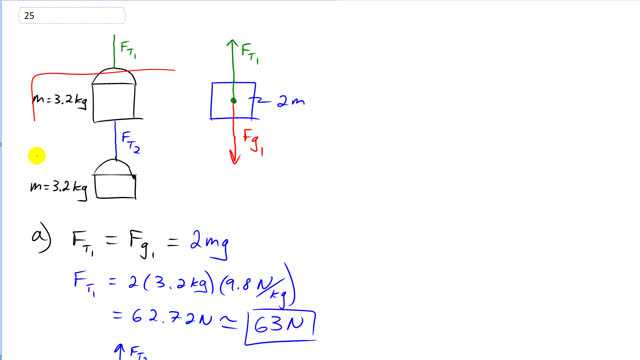
One 3.2-kg paint bucket is hanging by a massless cord from another 3.2-kg paint bucket, also hanging by a massless cord, as shown in Fig. 4–49.
- If the buckets are at rest, what is the tension in each cord?
- If the two buckets are pulled upward with an acceleration of by the upper cord, calculate the tension in each cord.


In order to watch this solution you need to have a subscription.
This is Giancoli Answers with Mr. Dychko. To calculate the tension force in this top piece of rope we have to consider what is it supporting. It's supporting both buckets and so, think of these two buckets as a single combined bucket of mass 2m 2 times one of the masses. Imagine both buckets are enclosed just in one box and this would be the same picture. And so we have force tension 1 up is going to equal this total gravity downwards on this imagined object which combines both buckets into one. That's one way to think about this. So, since they're not accelerating, that means the tension force up has to equal the gravity downwards. And gravity downwards is going to be 2m times g. So, that's two times 3.2 times kilograms times 9.8 Newtons per kilogram which gives 63 Newtons. And then when you're considering the bottom bucket, bucket 2. The tension force upwards there has to equal only the gravity downwards on that single bottom bucket, and so, the mass is just a single m. And up force equals the down force because there's no acceleration, and so, that equals mg, 3.2 times 9.8 is 31 Newtons of tension upwards. In part B it's the same type of picture but now it no longer equals, but the up force doesn't equal it down for us anymore. Instead we'll say, the net force, the up combined with the down has to equal mass times acceleration. And the mass is going to be 2 times m, m1, we're considering the the first case where you have the top bucket over the top piece of rope supporting both buckets. And we'll add Fg, you know, the combined gravity on that being supported or dealt with by the segment 1 of rope. So, add Fg1 to both sides and you get tension on the first rope is 2 ma plus Fg1, and so that's 2 times mg is Fg1. And then factor out the 2m and you get 2 times 3.2 times 1.25 meters per second squared acceleration upwards plus 9.8 meters per second squared which is 71 Newtons of force in the upper segment of rope. And then when you consider the bottom bucket it's the same picture and exactly the same calculation except that it's now a single m that we have to consider. And so, 3.2 kilograms times 1.25 plus 9.8 which gives 35 Newtons of tension upwards for the second segment of rope supporting the bottom bucket.